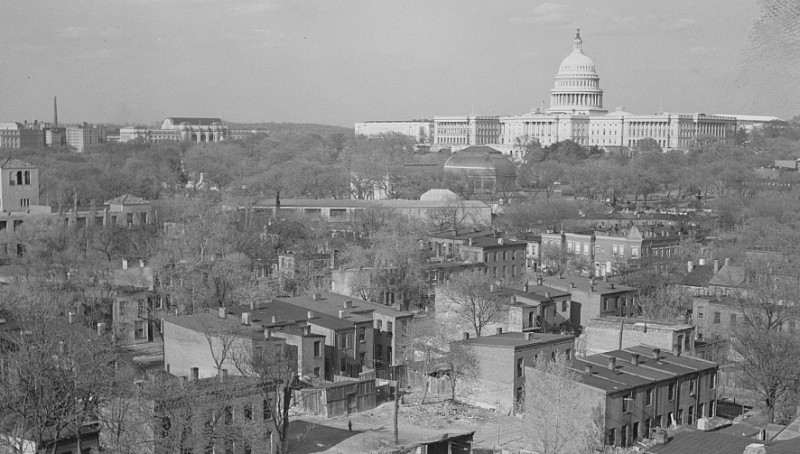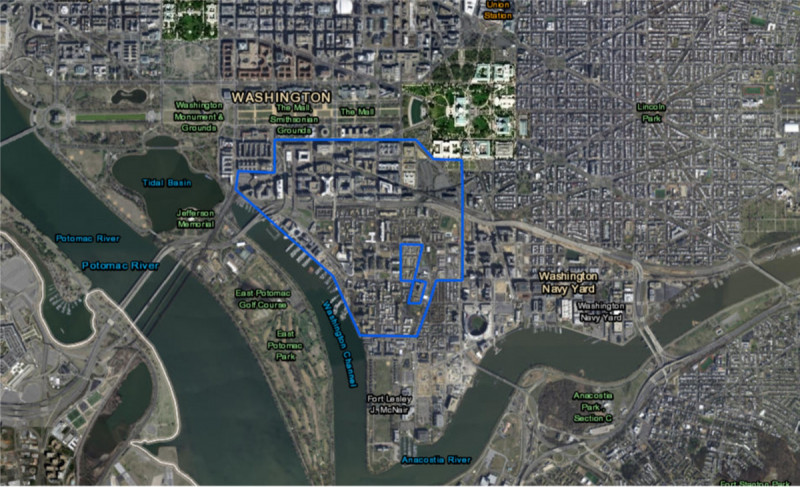Greenleaf Gardens was part of the birth of DC’s urban renewal projects

DC before the wave of urban renewal projects. Image by Library of Congress.
The DC Housing Authority’s current plan to raze and replace the Greenleaf Gardens public housing community with a mixed-income development is the most recent in a series of efforts over the decades to reinvent the Southwest neighborhood for a new class of residents.
In order to understand why all of this investment flocked toward the Southwest waterfront, it is important to understand how Greenleaf Gardens and its surrounding neighborhood initially came to be: Urban Renewal.
Urban Renewal is the concept that slums (read: densely-populated, working-class areas with older housing) should be replaced with newer, planned neighborhoods that attract the middle class. In the early 1900s, several cities in the US and worldwide, including DC, tried their hand at renewal projects. But Urban Renewal as we know it started in the late 1940s.
During this time, Congress gave federal, state and local governments the authority to purchase property (through eminent domain) in areas deemed blighted and in need of a comprehensively-planned mixed-income redevelopment.
DC post-urban renewal by Library of Congress.
Southwest fit the bill, having evolved from a slave-trading and industrial port to an ethnically-diverse, densely-populated working-class neighborhood lined with alley dwellings where half the houses lacked indoor plumbing.
Because the neighborhood was so close to the Capitol, the media was very effective in painting Southwest as an eyesore. Even the National Capital Planning Commission dubbed Southwest a “problem area” in its 1950 Comprehensive Plan.
In 1952, two business owners on Fourth Street SW, one of the neighborhood’s main commercial corridors, sued the Redevelopment Land Agency (RLA) tasked with Urban Renewal projects, objecting to how Congress defined “slum” and “blight”, and arguing against their property being seized for use by private developers.
The resulting 1954 Supreme Court case affirmed eminent domain, and Southwest became the first formal Urban Renewal project in DC. Meanwhile, construction of the “inner loop” freeway carved up the street grid and divided Southwest from the rest of the city, catering to commuters from the growing suburbs and laying the groundwork for the new neighborhood to come.
A map of the Southwest urban renewal area. Image licensed under Creative Commons.
In 1954, “slum clearance” began across the 560 acres southwest of South Capitol Street and Independence Avenue, leveling 99% of the buildings in the renewal area. By 1960, over 23,000 people had been displaced to create a “new town in the city.” Although the RLA initially required low-cost housing to be incorporated in the new construction, those requirements were quietly rolled back, and many of the displaced used the relocation assistance offered to move elsewhere in the city.
Because African Americans made up the majority of residents forced to relocate, having made up 69% of the population in 1950, prominent figures such as James Baldwin referred to the process as “Negro Removal”. As of 1960, the Washington Housing Association estimated that only 12% of the displaced households were able to return to the quadrant.
Some of the uprooted lower-income residents were able to remain in the neighborhood at St. James Mutual Homes (the only multifamily community to outlast Urban Renewal), Channel Square Apartments, and public housing on the outskirts of the redevelopment area, such as Greenleaf Gardens.
The first buildings of Greenleaf Gardens were constructed in 1957 by what was then called the National Capital Housing Authority. The community is likely named after James Greenleaf, who is considered one of the country’s earliest land speculators. Greenleaf went deep into debt purchasing tens of thousands of acres of land in DC in the early 1790s. He especially had a presence in Southwest—he is responsible for the historic houses at Wheat Row, and “Greenleaf Point” is another name for Buzzard Point.
By the late 1970s, the newly-built neighborhood looked completely different, catering to middle- and upper-class families with its more suburban scale. About 13,000 residents lived in roughly 5,800 units, including over 900 new public housing units.
Almost 60 years later, Southwest is in the middle of another transition, and the specter of Negro Removal continues to loom. The concentration of development within a mile of Greenleaf Gardens is reminiscent of Urban Renewal, minus the eminent domain.
